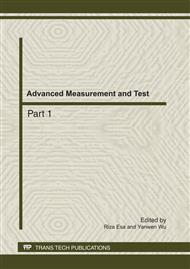[1]
Ma Junhui: HS-SPME-GC-MS in the Establishment and Application of Methods to the Determination of Tea Aroma Components. Hangzhou: Zhejiang university (2008).
Google Scholar
[2]
Mitsuya Shimoda, Hiroko Shigematsu and Hideki Shiratsuchi: Comparison of the Odor Concentrates by SDE and Adsorptive Column Method from Green Tea Infusion. Agric Food Chem, Vol. 43 (1995), pp.1616-1620.
DOI: 10.1021/jf00054a037
Google Scholar
[3]
Ding Fanglin, Dong Yisheng and Peng Shulian: Determination of Volatile Components in Tea by SDE-GC-MS. China Brewing, Vol. 4 (2009), pp.147-150.
Google Scholar
[4]
Hou Dongyan, Hui ruihua and Li Tiechun etc.: Study on Elavour Components of Teas: Comparison of Flavour Components by Wulong Tea and Raw Tea. Journal of Anshan Normal University, Vol. 5 (2003), pp.53-55.
Google Scholar
[5]
Zhu Qi, Shi Zhaopeng and Ren Chunmei: Studies on the Different Aroma Making Methods of Green Tea Aroma. Journal of Tea Science, Vol. 21 (2005), pp.38-43.
Google Scholar
[6]
Zhu Qi,Shi Zhaopeng and Ren Chunmei: Changes of Aroma of Instant Green Tea During the Process by Vaccum Distillation Extract. Journal of Hunan Agricultural University (Natural Sciences), Vol. 27 (2001), pp.218-220.
Google Scholar
[7]
Mosandl A: Capillary Gas Chromatography in Quality Assessment of Flavours and Fragrances. Chromatogr, Vol. 624 (1992), pp.267-292.
DOI: 10.1016/0021-9673(92)85684-l
Google Scholar
[8]
Tan Heping, Li Bin and Zhang Yunchang etc.: Investigation of Tea Aroma by Static Headspace GC-MS. China Measure, Vol. 35 (2009), pp.62-64.
Google Scholar
[9]
Zhu Qi, Shi Zhaopeng and Ren Chunmei: Analysis of Aroma of Instant Green Tea by Headspace Absorption and Tea Liquid Absorption. Journal of Hunan Agricultural University (Natural Sciences), Vol. 6 (2001), pp.466-468.
Google Scholar
[10]
Ye Neixing and Yang Guang etc.: Analysis of the Aroma of Refined Baked Green Tea Using SPME/GC-MS. Journal of Fujian Agriculture and Forestry University, Vol. 35 (2006), pp.165-168.
Google Scholar
[11]
Liu Laping, Shi Yage and Zhang Ruiming: Analysis of Aromatic Components in Wuzi Green Tea by SPME-GC-MS. Acta Botanica Boreali-Occidentalia Sinica, Vol. 27 (2007), pp.371-376.
Google Scholar
[12]
Lv Haipeng, Zhong Qiusheng and Lin Zhi: Study on the Aroma Components in Pu-erh Tea with Stale Flavor. Journal of Tea Science, Vol. 29 (2009), pp.219-224.
Google Scholar
[13]
Wang Li, Cai Liangsui and Lin Zhi: Head-space Solid Phase Microextraction and GC-MS Analysis of Fragrance of White Tea. Journal of Tea Science, Vol. 30 (2010), pp.115-123.
Google Scholar
[14]
He Jianyun, Wang Bin and Yang Ziming: Analysis of Volatility Oil from Herbal Tea. Chemistry & Bioengineering, Vol. 27 (2010), pp.85-88.
Google Scholar
[15]
Li Xuechun, Xiang Xiaoling and Yu Yuhong: Contrast Research on Aroma Components of Organic Tea in Fenggang of Guizhou by Electronic Nose and GC-MS. 2009·Innovation and Research Forum of National Herbs, Conference papers (2009), pp.404-410.
Google Scholar


